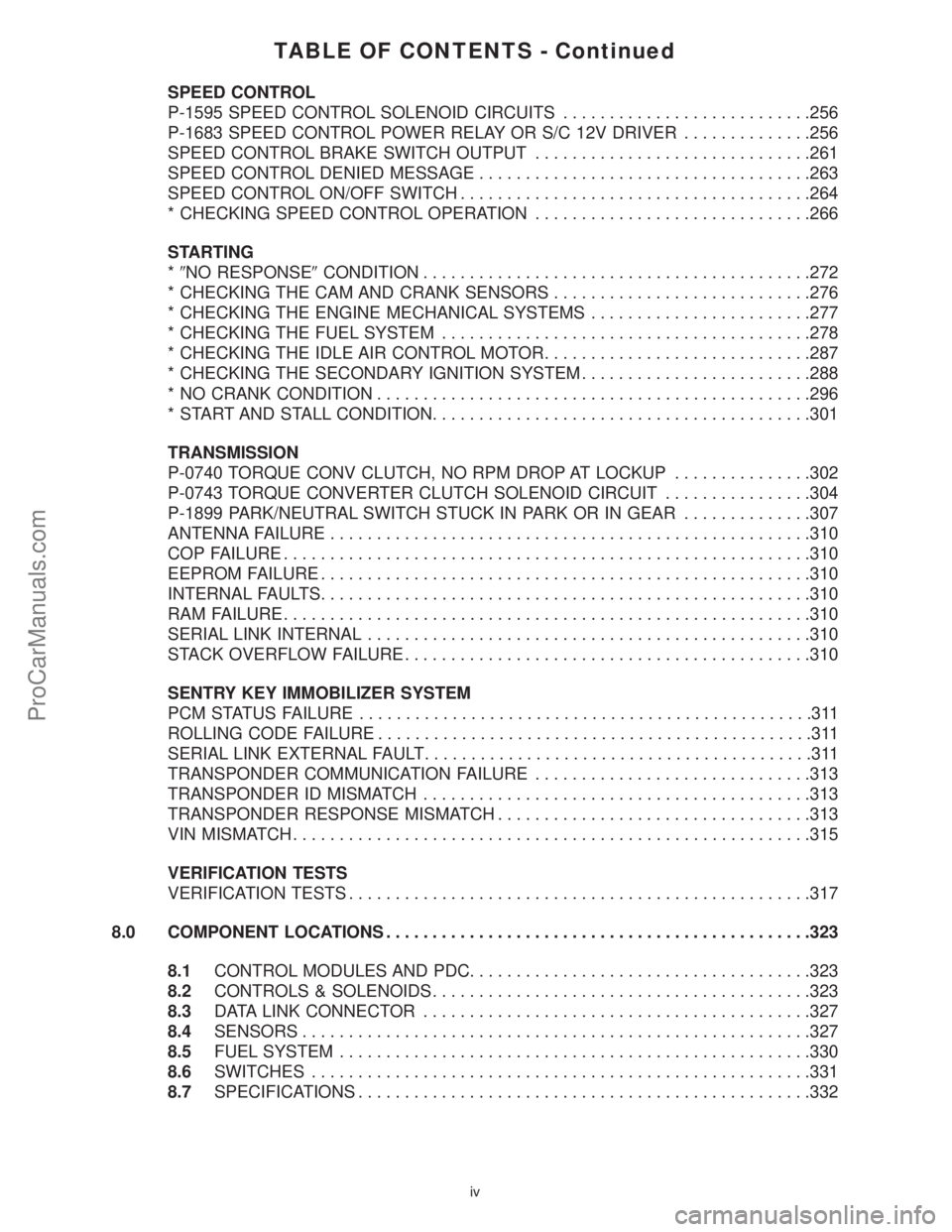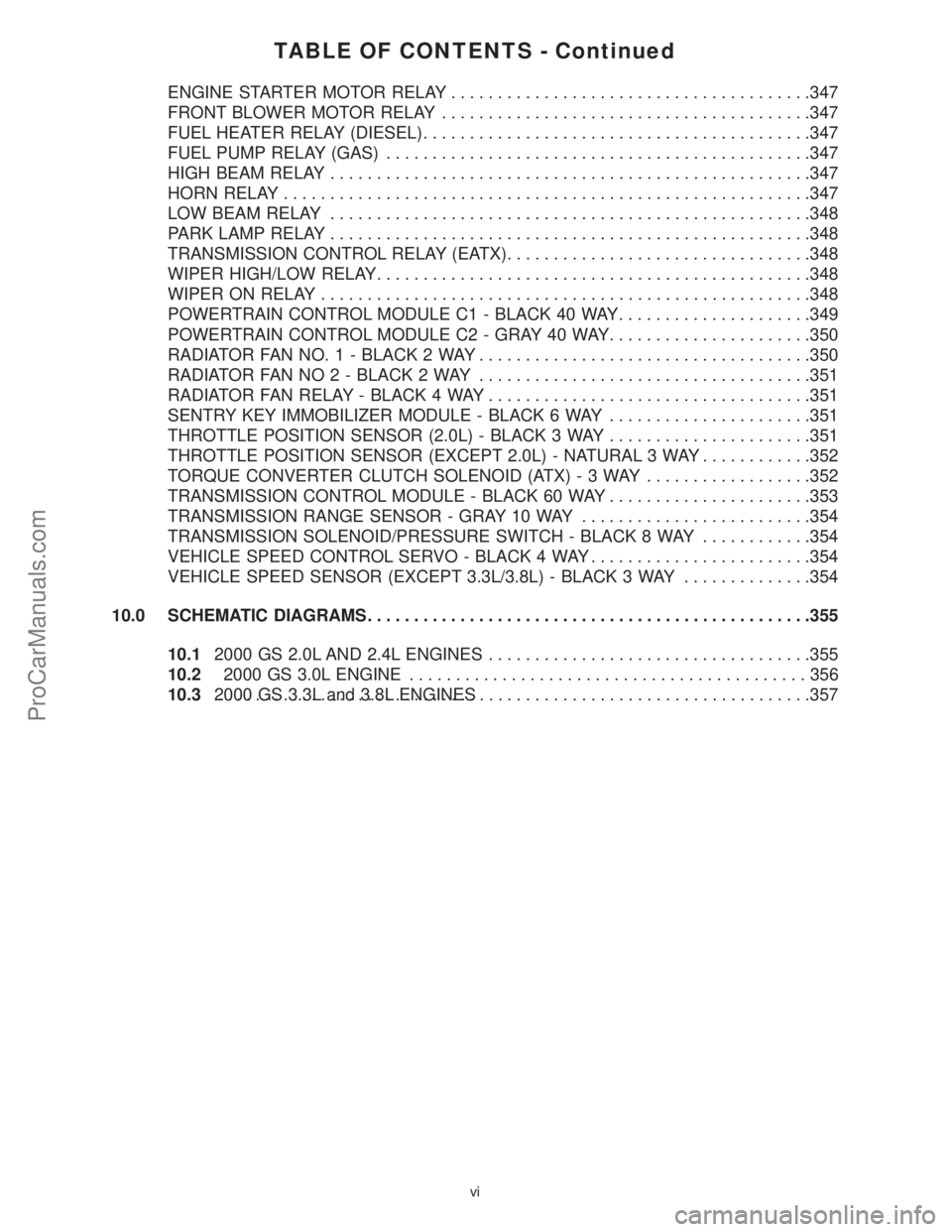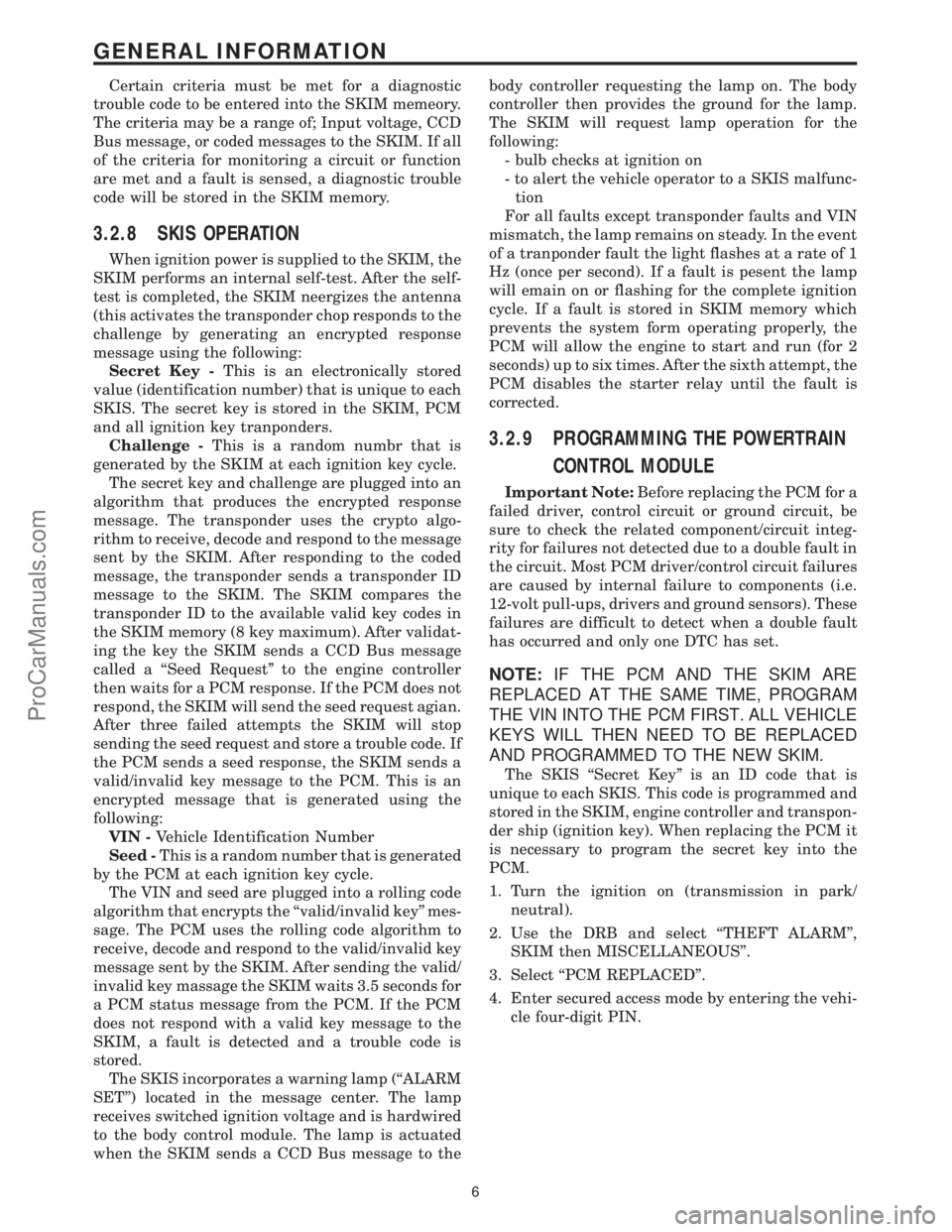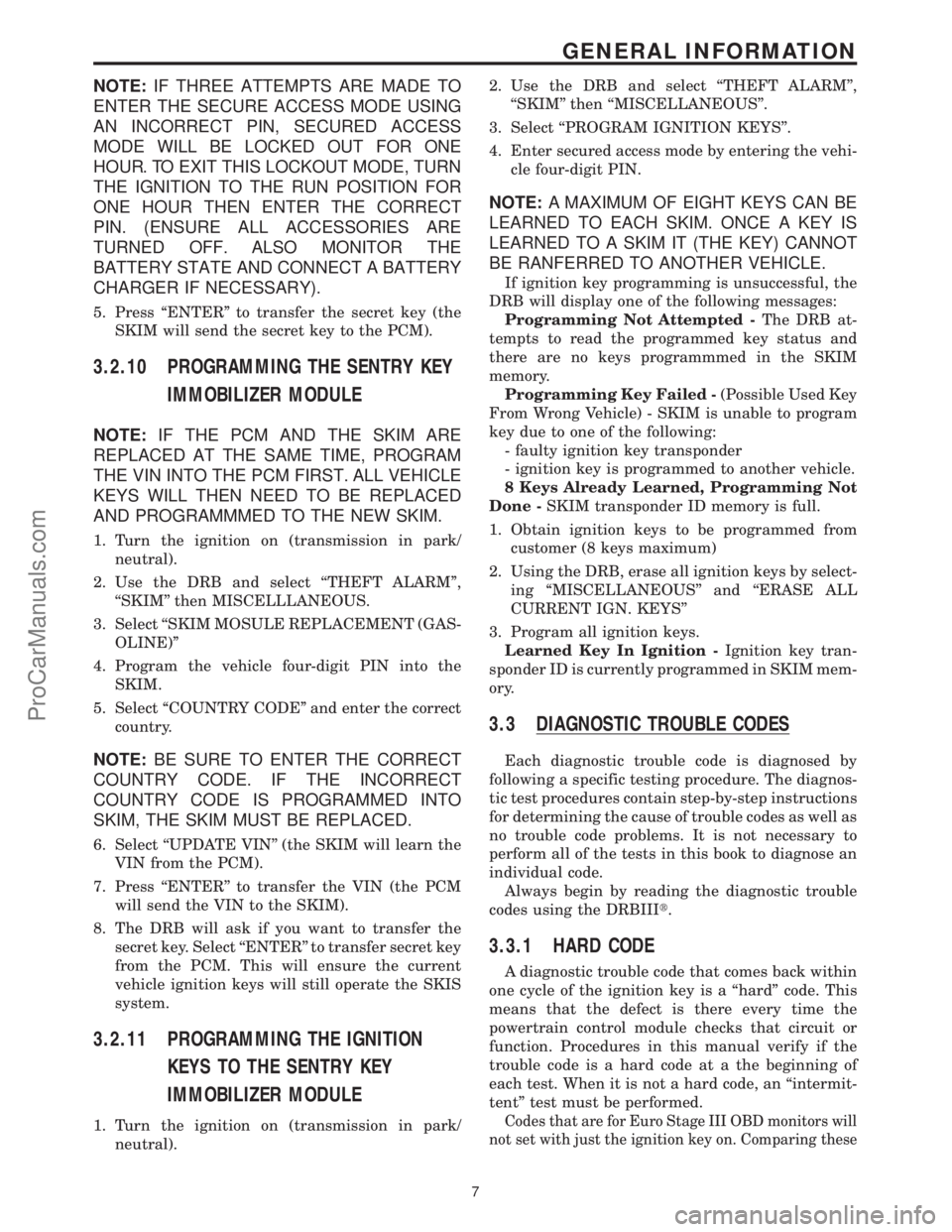manual transmission CHRYSLER VOYAGER 2000 Diagnostic Manual
[x] Cancel search | Manufacturer: CHRYSLER, Model Year: 2000, Model line: VOYAGER, Model: CHRYSLER VOYAGER 2000Pages: 364, PDF Size: 2.17 MB
Page 4 of 364

TABLE OF CONTENTS - Continued
SPEED CONTROL
P-1595 SPEED CONTROL SOLENOID CIRCUITS...........................256
P-1683 SPEED CONTROL POWER RELAY OR S/C 12V DRIVER..............256
SPEED CONTROL BRAKE SWITCH OUTPUT..............................261
SPEED CONTROL DENIED MESSAGE....................................263
SPEED CONTROL ON/OFF SWITCH......................................264
* CHECKING SPEED CONTROL OPERATION..............................266
STARTING
*9NO RESPONSE9CONDITION..........................................272
* CHECKING THE CAM AND CRANK SENSORS............................276
* CHECKING THE ENGINE MECHANICAL SYSTEMS........................277
* CHECKING THE FUEL SYSTEM........................................278
* CHECKING THE IDLE AIR CONTROL MOTOR.............................287
* CHECKING THE SECONDARY IGNITION SYSTEM.........................288
* NO CRANK CONDITION...............................................296
* START AND STALL CONDITION.........................................301
TRANSMISSION
P-0740 TORQUE CONV CLUTCH, NO RPM DROP AT LOCKUP...............302
P-0743 TORQUE CONVERTER CLUTCH SOLENOID CIRCUIT................304
P-1899 PARK/NEUTRAL SWITCH STUCK IN PARK OR IN GEAR..............307
ANTENNA FAILURE....................................................310
COP FAILURE.........................................................310
EEPROM FAILURE.....................................................310
INTERNAL FAULTS.....................................................310
RAM FAILURE.........................................................310
SERIAL LINK INTERNAL................................................310
STACK OVERFLOW FAILURE............................................310
SENTRY KEY IMMOBILIZER SYSTEM
PCM STATUS FAILURE.................................................311
ROLLING CODE FAILURE...............................................311
SERIAL LINK EXTERNAL FAULT..........................................311
TRANSPONDER COMMUNICATION FAILURE..............................313
TRANSPONDER ID MISMATCH..........................................313
TRANSPONDER RESPONSE MISMATCH..................................313
VIN MISMATCH........................................................315
VERIFICATION TESTS
VERIFICATION TESTS..................................................317
8.0 COMPONENT LOCATIONS..............................................323
8.1CONTROL MODULES AND PDC.....................................323
8.2CONTROLS & SOLENOIDS.........................................323
8.3DATA LINK CONNECTOR..........................................327
8.4SENSORS.......................................................327
8.5FUEL SYSTEM...................................................330
8.6SWITCHES......................................................331
8.7SPECIFICATIONS.................................................332
iv
ProCarManuals.com
Page 6 of 364

TABLE OF CONTENTS - Continued
ENGINE STARTER MOTOR RELAY.......................................347
FRONT BLOWER MOTOR RELAY........................................347
FUEL HEATER RELAY (DIESEL)..........................................347
FUEL PUMP RELAY (GAS)..............................................347
HIGH BEAM RELAY....................................................347
HORN RELAY.........................................................347
LOW BEAM RELAY....................................................348
PARK LAMP RELAY....................................................348
TRANSMISSION CONTROL RELAY (EATX).................................348
WIPER HIGH/LOW RELAY...............................................348
WIPER ON RELAY.....................................................348
POWERTRAIN CONTROL MODULE C1 - BLACK 40 WAY.....................349
POWERTRAIN CONTROL MODULE C2 - GRAY 40 WAY......................350
RADIATOR FAN NO. 1 - BLACK 2 WAY....................................350
RADIATOR FAN NO 2 - BLACK 2 WAY....................................351
RADIATOR FAN RELAY - BLACK 4 WAY...................................351
SENTRY KEY IMMOBILIZER MODULE - BLACK 6 WAY......................351
THROTTLE POSITION SENSOR (2.0L) - BLACK 3 WAY......................351
THROTTLE POSITION SENSOR (EXCEPT 2.0L) - NATURAL 3 WAY............352
TORQUE CONVERTER CLUTCH SOLENOID (ATX)-3WAY..................352
TRANSMISSION CONTROL MODULE - BLACK 60 WAY......................353
TRANSMISSION RANGE SENSOR - GRAY 10 WAY.........................354
TRANSMISSION SOLENOID/PRESSURE SWITCH - BLACK 8 WAY............354
VEHICLE SPEED CONTROL SERVO - BLACK 4 WAY........................354
VEHICLE SPEED SENSOR (EXCEPT 3.3L/3.8L) - BLACK 3 WAY..............354
10.0 SCHEMATIC DIAGRAMS................................................355
10.12000 GS 2.0L AND 2.4L ENGINES...................................355
10.22000 GS 3.0L ENGINE...........................................356
10.32000 GS 3.3L and 3.8L ENGINES................................................................357
vi
ProCarManuals.com
Page 12 of 364

Certain criteria must be met for a diagnostic
trouble code to be entered into the SKIM memeory.
The criteria may be a range of; Input voltage, CCD
Bus message, or coded messages to the SKIM. If all
of the criteria for monitoring a circuit or function
are met and a fault is sensed, a diagnostic trouble
code will be stored in the SKIM memory.
3.2.8 SKIS OPERATION
When ignition power is supplied to the SKIM, the
SKIM performs an internal self-test. After the self-
test is completed, the SKIM neergizes the antenna
(this activates the transponder chop responds to the
challenge by generating an encrypted response
message using the following:
Secret Key -This is an electronically stored
value (identification number) that is unique to each
SKIS. The secret key is stored in the SKIM, PCM
and all ignition key tranponders.
Challenge -This is a random numbr that is
generated by the SKIM at each ignition key cycle.
The secret key and challenge are plugged into an
algorithm that produces the encrypted response
message. The transponder uses the crypto algo-
rithm to receive, decode and respond to the message
sent by the SKIM. After responding to the coded
message, the transponder sends a transponder ID
message to the SKIM. The SKIM compares the
transponder ID to the available valid key codes in
the SKIM memory (8 key maximum). After validat-
ing the key the SKIM sends a CCD Bus message
called a ``Seed Request'' to the engine controller
then waits for a PCM response. If the PCM does not
respond, the SKIM will send the seed request agian.
After three failed attempts the SKIM will stop
sending the seed request and store a trouble code. If
the PCM sends a seed response, the SKIM sends a
valid/invalid key message to the PCM. This is an
encrypted message that is generated using the
following:
VIN -Vehicle Identification Number
Seed -This is a random number that is generated
by the PCM at each ignition key cycle.
The VIN and seed are plugged into a rolling code
algorithm that encrypts the ``valid/invalid key'' mes-
sage. The PCM uses the rolling code algorithm to
receive, decode and respond to the valid/invalid key
message sent by the SKIM. After sending the valid/
invalid key massage the SKIM waits 3.5 seconds for
a PCM status message from the PCM. If the PCM
does not respond with a valid key message to the
SKIM, a fault is detected and a trouble code is
stored.
The SKIS incorporates a warning lamp (``ALARM
SET'') located in the message center. The lamp
receives switched ignition voltage and is hardwired
to the body control module. The lamp is actuated
when the SKIM sends a CCD Bus message to thebody controller requesting the lamp on. The body
controller then provides the ground for the lamp.
The SKIM will request lamp operation for the
following:
- bulb checks at ignition on
- to alert the vehicle operator to a SKIS malfunc-
tion
For all faults except transponder faults and VIN
mismatch, the lamp remains on steady. In the event
of a tranponder fault the light flashes at a rate of 1
Hz (once per second). If a fault is pesent the lamp
will emain on or flashing for the complete ignition
cycle. If a fault is stored in SKIM memory which
prevents the system form operating properly, the
PCM will allow the engine to start and run (for 2
seconds) up to six times. After the sixth attempt, the
PCM disables the starter relay until the fault is
corrected.
3.2.9 PROGRAMMING THE POWERTRAIN
CONTROL MODULE
Important Note:Before replacing the PCM for a
failed driver, control circuit or ground circuit, be
sure to check the related component/circuit integ-
rity for failures not detected due to a double fault in
the circuit. Most PCM driver/control circuit failures
are caused by internal failure to components (i.e.
12-volt pull-ups, drivers and ground sensors). These
failures are difficult to detect when a double fault
has occurred and only one DTC has set.
NOTE:IF THE PCM AND THE SKIM ARE
REPLACED AT THE SAME TIME, PROGRAM
THE VIN INTO THE PCM FIRST. ALL VEHICLE
KEYS WILL THEN NEED TO BE REPLACED
AND PROGRAMMED TO THE NEW SKIM.
The SKIS ``Secret Key'' is an ID code that is
unique to each SKIS. This code is programmed and
stored in the SKIM, engine controller and transpon-
der ship (ignition key). When replacing the PCM it
is necessary to program the secret key into the
PCM.
1. Turn the ignition on (transmission in park/
neutral).
2. Use the DRB and select ``THEFT ALARM'',
SKIM then MISCELLANEOUS''.
3. Select ``PCM REPLACED''.
4. Enter secured access mode by entering the vehi-
cle four-digit PIN.
6
GENERAL INFORMATION
ProCarManuals.com
Page 13 of 364

NOTE:IF THREE ATTEMPTS ARE MADE TO
ENTER THE SECURE ACCESS MODE USING
AN INCORRECT PIN, SECURED ACCESS
MODE WILL BE LOCKED OUT FOR ONE
HOUR. TO EXIT THIS LOCKOUT MODE, TURN
THE IGNITION TO THE RUN POSITION FOR
ONE HOUR THEN ENTER THE CORRECT
PIN. (ENSURE ALL ACCESSORIES ARE
TURNED OFF. ALSO MONITOR THE
BATTERY STATE AND CONNECT A BATTERY
CHARGER IF NECESSARY).
5. Press ``ENTER'' to transfer the secret key (the
SKIM will send the secret key to the PCM).
3.2.10 PROGRAMMING THE SENTRY KEY
IMMOBILIZER MODULE
NOTE:IF THE PCM AND THE SKIM ARE
REPLACED AT THE SAME TIME, PROGRAM
THE VIN INTO THE PCM FIRST. ALL VEHICLE
KEYS WILL THEN NEED TO BE REPLACED
AND PROGRAMMMED TO THE NEW SKIM.
1. Turn the ignition on (transmission in park/
neutral).
2. Use the DRB and select ``THEFT ALARM'',
``SKIM'' then MISCELLLANEOUS.
3. Select ``SKIM MOSULE REPLACEMENT (GAS-
OLINE)''
4. Program the vehicle four-digit PIN into the
SKIM.
5. Select ``COUNTRY CODE'' and enter the correct
country.
NOTE:BE SURE TO ENTER THE CORRECT
COUNTRY CODE. IF THE INCORRECT
COUNTRY CODE IS PROGRAMMED INTO
SKIM, THE SKIM MUST BE REPLACED.
6. Select ``UPDATE VIN'' (the SKIM will learn the
VIN from the PCM).
7. Press ``ENTER'' to transfer the VIN (the PCM
will send the VIN to the SKIM).
8. The DRB will ask if you want to transfer the
secret key. Select ``ENTER'' to transfer secret key
from the PCM. This will ensure the current
vehicle ignition keys will still operate the SKIS
system.
3.2.11 PROGRAMMING THE IGNITION
KEYS TO THE SENTRY KEY
IMMOBILIZER MODULE
1. Turn the ignition on (transmission in park/
neutral).2. Use the DRB and select ``THEFT ALARM'',
``SKIM'' then ``MISCELLANEOUS''.
3. Select ``PROGRAM IGNITION KEYS''.
4. Enter secured access mode by entering the vehi-
cle four-digit PIN.
NOTE:A MAXIMUM OF EIGHT KEYS CAN BE
LEARNED TO EACH SKIM. ONCE A KEY IS
LEARNED TO A SKIM IT (THE KEY) CANNOT
BE RANFERRED TO ANOTHER VEHICLE.
If ignition key programming is unsuccessful, the
DRB will display one of the following messages:
Programming Not Attempted -The DRB at-
tempts to read the programmed key status and
there are no keys programmmed in the SKIM
memory.
Programming Key Failed -(Possible Used Key
From Wrong Vehicle) - SKIM is unable to program
key due to one of the following:
- faulty ignition key transponder
- ignition key is programmed to another vehicle.
8 Keys Already Learned, Programming Not
Done -SKIM transponder ID memory is full.
1. Obtain ignition keys to be programmed from
customer (8 keys maximum)
2. Using the DRB, erase all ignition keys by select-
ing ``MISCELLANEOUS'' and ``ERASE ALL
CURRENT IGN. KEYS''
3. Program all ignition keys.
Learned Key In Ignition -Ignition key tran-
sponder ID is currently programmed in SKIM mem-
ory.
3.3 DIAGNOSTIC TROUBLE CODES
Each diagnostic trouble code is diagnosed by
following a specific testing procedure. The diagnos-
tic test procedures contain step-by-step instructions
for determining the cause of trouble codes as well as
no trouble code problems. It is not necessary to
perform all of the tests in this book to diagnose an
individual code.
Always begin by reading the diagnostic trouble
codes using the DRBIIIt.
3.3.1 HARD CODE
A diagnostic trouble code that comes back within
one cycle of the ignition key is a ªhardº code. This
means that the defect is there every time the
powertrain control module checks that circuit or
function. Procedures in this manual verify if the
trouble code is a hard code at a the beginning of
each test. When it is not a hard code, an ªintermit-
tentº test must be performed.
Codes that are for Euro Stage III OBD monitors will
not set with just the ignition key on. Comparing these
7
GENERAL INFORMATION
ProCarManuals.com
Page 19 of 364

4.3.3 ELECTRONIC PINION FACTOR
WARNING
The pinion factor must be set for all new trans-
mission control modules. If the pinion factor is not
set or if it is set incorrectly, any speed-related
accessories will not operate or will operate inaccu-
rately. This includes the speedometer, speed con-
trol, rolling door locks, and other devices that are
operated by the powertrain and body control mod-
ules. For instructions on setting the pinion factor,
see the appropriate transmission diagnostic man-
ual or the service manual.
5.0 RECOMMENDED TOOLS
AND EQUIPMENT
DRBIIIt(diagnostic readout box) scan tool
fuel pressure adapter (C-6631) or #6539
fuel pressure kit (C-4799-B) or #5069
fuel release hose (C-4799-1)
MinAir flow fitting #6457
jumper wires
ohmmeter
oscilloscope
vacuum gauge
voltmeter
12 volt test light minimum 25 ohms resistance
with probe #8382
CAUTION: A 12 VOLT TEST LIGHT SHOULD
NOT BE USED FOR THE FOLLOWING
CIRCUITS, DAMAGE TO THE POWERTRAIN
CONTROLLER WILL OCCUR.
²5 Volt Supply
²8 Volt Supply
²J1850 PCI Bus
²CCD Bus
²CKP Sensor Signal
²CMP Sensor Signal
²Vehicle Speed Sensor Signal
²O2 Sensor Signal
6.0 GLOSSARY OF TERMS
ABSantilock brake system
backfire,
popbackfuel ignites in either the intake or
the exhaust system
CKPcrank position sensor
CMPcamshaft position sensor
cuts out,
missesa steady pulsation or the inability of
the engine to maintain a consistent
rpmDLCdata link connector (previously
called ªengine diagnostic connectorº)
detona-
tion,
spark
knocka mild to severe ping, especially un-
der loaded engine conditions
ECTengine coolant temperature sensor
EGRexhaust gas recirculation valve and
system
genera-
torpreviously called ªalternatorº
hard
startThe engine takes longer than usual
to start, even though it is able to
crank normally.
hesita-
tion, sag,
stumble
There is a momentary lack of response
when the throttle is opened.
This can
occur at all vehicle speeds. If it is se-
vere enough, the engine may stall.
IATintake air temperature sensor
IACidle air control valve
JTECCombined engine and transmission
control module
lack of
power,
sluggish
The engine has less than expected
power, with little or no increase in vehi-
cle speed when the throttle is opened.
LDPLeak Detection Pump
MAPmanifold absolute pressure sensor
MILmalfunction indicator lamp
MTVmanifold tuning valve
O2Soxygen sensor
PCIProgrammable Communication In-
terface
PCMpowertrain control module
PCMpowertrain control module
PCVpositive crankcase ventilation
PEPPeripheral Expansion Port
poor fuel
economyThere is significantly less fuel mile-
age than other vehicles of the same
design and configuration
rough,
unstable,
or er-
ratic idle
stallingThe engine runs unevenly at idle
and causes the engine to shake if it
is severe enough. The engine idle
rpm may vary (called ªhuntingº).
This condition may cause stalling if
it is severe enough.
SKIMSentry Key Immobilizer Module
SKISSentry Key Immobilizer System
start and
stallThe engine starts but immediately
dies.
13
GENERAL INFORMATION
ProCarManuals.com
Page 20 of 364

surgeengine rpm fluctuation without cor-
responding change in throttle posi-
tion sensor
TPSthrottle position sensorTRStransmission range sensor
VSSvehicle speed sensor/signal
14
GENERAL INFORMATION
ProCarManuals.com
Page 51 of 364

Symptom:
P-0122 THROTTLE POSITION SENSOR VOLTAGE LOW
When Monitored and Set Condition:
P-0122 THROTTLE POSITION SENSOR VOLTAGE LOW
When Monitored: With the ignition on.
Set Condition: The TP sensor signal voltage goes below 0.16 volt.
POSSIBLE CAUSES
TPS 5-VOLT SUPPLY CIRCUIT OPEN
TPS SIGNAL CIRCUIT SHORT TO GROUND
TPS SIGNAL CIRCUIT SHORT TO SENSOR GROUND CIRCUIT
TPS WIRING HARNESS INTERMITTENT DEFECT
TPS WIRING HARNESS OBSERVABLE DEFECT
PCM DEFECTIVE (TPS)
THROTTLE POSITION SENSOR DEFECTIVE
THROTTLE POSITION SENSOR VOLTAGE CHANGE NOT SMOOTH
TRANSMISSION CONTROL MODULE DEFECTIVE (TPS)
TEST ACTION APPLICABILITY
1 Turn key on, engine off.
With the DRB, read the Throttle Position Sensor (TP Sensor) voltage.
Is the Throttle Position Sensor voltage below 0.16 volt?All
Ye s®Go To 2
No®Go To 8
2 Ignition Off
Disconnect the Throttle Position Sensor.
Note: Check connectors - Clean/repair as necessary.
Ignition On, Engine Not Running.
Measure the voltage at the 5-Volt Supply Circuit at TPS Connector.
Is the voltage below 4.0 volts?All
Ye s®Repair the open TP Sensor 5-Volt Supply Circuit.
Perform Powertrain Verification Test VER-5A.
No®Go To 3
45
DRIVEABILITY
ProCarManuals.com
Page 52 of 364

TEST ACTION APPLICABILITY
3 Ignition Off
Disconnect the Throttle Position Sensor.
Note: Check connectors - Clean repair as necessary.
Ignition On, Engine Not Running.
With the DRB, read the Throttle Position Sensor voltage.
Is the voltage above 1.0 volt?All
Ye s®Replace the Throttle Position Sensor.
Perform Powertrain Verification Test VER-5A.
No®Go To 4
4 Ignition Off
Disconnect the Throttle Position Sensor.
Disconnect the Transmission Control Module.
Disconnect the PCM.
Note: Check connectors - Clean/repair as necessary.
Measure the resistance between the TP Sensor Signal Circuit and ground.
Is the resistance below 5.0 ohms?All
Ye s®Repair the Throttle Position Sensor Signal Circuit for a short to
ground.
Perform Powertrain Verification Test VER-5A.
No®Go To 5
5 Ignition Off
Disconnect the Throttle Position Sensor.
Disconnect the Transmission Control Module.
Disconnect the PCM.
Note: Check connectors - Clean/repair as necessary.
Measure the resistance between the TP Sensor Signal Circuit and the Sensor Ground
Circuit.
Is the resistance below 5.0 ohms?All
Ye s®Repair the Sensor Signal Circuit shorted to Sensor Ground
Circuit.
Perform Powertrain Verification Test VER-5A.
No®Go To 6
6 Ignition Off
Disconnect the Throttle Position Sensor.
Disconnect the Transmission Control Module if equipped..
Note: Check connectors - Clean/repair as necessary.
Key On
With the DRB, read the Throttle Position Sensor voltage.
Is the voltage above 1.0 volt?All
Ye s®Replace the Transmission Control Module.
Perform Powertrain Verification Test VER-5A.
No®Go To 7
7 If there are no potential causes remaining, the Powertrain Control Module is
assumed to be defective.
View repair options.All
Repair
Replace the PCM.
Perform Powertrain Verification Test VER-5A.
46
DRIVEABILITY
P-0122 THROTTLE POSITION SENSOR VOLTAGE LOW ÐContinued
ProCarManuals.com
Page 55 of 364

TEST ACTION APPLICABILITY
3 Ignition Off
Disconnect the Throttle Position Sensor Connector.
Disconnect the Powertrain Control Module Connector.
Note: Check connectors - Clean/repair as necessary.
Using an Ohmmeter, measure between the 5-volt Supply Circuit and the Throttle
Position Sensor Signal Circuit at the Throttle Position Sensor Connector.
Is the resistance below 5.0 ohms?All
Ye s®Repair the Throttle Position Sensor Signal Circuit shorted to the
5-volt Supply Circuit.
Perform Powertrain Verification Test VER-5A.
No®Go To 4
4 Turn the Ignition Off
Disconnect the TCM harness connector.
Turn the Ignition On.
Using the DRB, monitor the TP sensor voltage.
Is the voltage below 1.0 volt?All
Ye s®Replace the Transmission Control Module.
No®Go To 5
5 Ignition Off
Disconnect the Throttle Position Sensor Connector.
Note: Check connectors - Clean/repair as necessary.
Connect a jumper wire between the Throttle Position Sensor Signal Circuit and
Sensor Ground Circuit.
Ignition on, engine not running.
Using the DRB, read the Throttle Position Sensor voltage.
Is the voltage below 1.0 volt?All
Ye s®Replace the Throttle Position Sensor.
Perform Powertrain Verification Test VER-5A.
No®Go To 6
6 Ignition Off
Disconnect the TPS Electrical Connector.
Note: Check connectors - Clean/repair as necessary.
Connect a jumper wire between the TPS Signal Circuit and a good engine ground.
Ignition on, engine not running.
Using the DRB, read the Throttle Position Sensor voltage.
Is the voltage below 1.0 volt?All
Ye s®Repair the open Throttle Position Sensor Ground Circuit.
Perform Powertrain Verification Test VER-5A.
No®Go To 7
49
DRIVEABILITY
P-0123 THROTTLE POSITION SENSOR VOLTAGE HIGH ÐContinued
ProCarManuals.com
Page 63 of 364

Symptom:
P-0133 1/1 O2S SLOW RESPONSE
When Monitored and Set Condition:
P-0133 1/1 O2S SLOW RESPONSE
When Monitored: With engine temperature greater than 63 degrees C (147 degrees F),
after reaching vehicle speed of 16 kmh (10 mph), and throttle remaining open (off idle), for
2 minutes bring vehicle to a stop and allow engine to idle with transmission in drive (auto)
or in neutral (manual).
Set Condition: The Oxygen Sensor Signal voltage is switching from below 0.27 volt to
above 0.62 volt and back fewer times than required.
POSSIBLE CAUSES
ENGINE MECHANICAL PROBLEM
1/1 O2 SENSOR GROUND CKT HIGH RESISTANCE
1/1 O2 SENSOR GROUND CKT POOR CONNECTION
1/1 O2 SENSOR SIGNAL CKT HIGH RESISTANCE
1/1 O2 SENSOR SIGNAL CKT POOR CONNECTION
1/1 O2 SENSOR SLOW RESPONSE
EXHAUST LEAK
1/1 O2S SLOW RESPONSE DOES NOT REOCCUR
TEST ACTION APPLICABILITY
1 With the DRB, read the DTCs.
Is the GLOBAL GOOD TRIP counter displayed and equal to zero?All
Ye s®Go To 5
No®Go To 2
2 Turn Ignition On (Engine Off).
During the following voltage drop measurement, wiggle wires between O2S Connec-
tor and PCM Connector.
Using a voltmeter, backprobe O2S (Sensor Ground) Circuit between O2S Connector
(Sensor Ground) and PCM Connector (Sensor Ground).
While wiggling wires, is the voltage drop reading below 0.10 VDC?All
Ye s®Go To 3
No®Repair poor connection (high resistance) on O2 Sensor Ground
Circuit.
Perform VERIFICATION TEST VER-5A3.
57
DRIVEABILITY
ProCarManuals.com